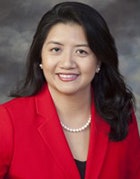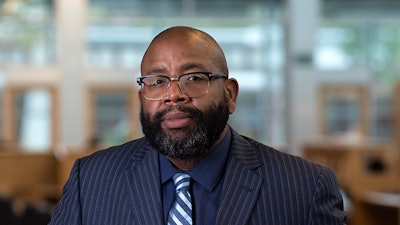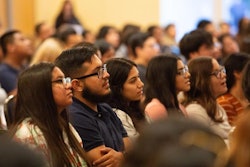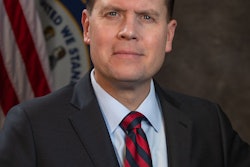 Thuy Thi Nguyen, president of Foothill College
Thuy Thi Nguyen, president of Foothill College
“What has changed in how we center race in faculty hiring is that first and foremost, we have centered race,” said panelist Thuy Thi Nguyen, president of Foothill College, a community college in Los Altos Hills. “At my college, I am making a case for students, that student equity gaps close because of faculty diversity.”
The University of Southern California (USC)’s Center for Urban Education (CUBE) hosted the webinar. Dr. Estela Mara Bensimon, founding director of the CUBE and professor emerita of higher education at USC moderated the conversation. Bensimon opened the discussion with research that backed up Nguyen’s case: how all students, particularly students of color, get stronger academic outcomes when faculty of color are teaching in the classroom.
“We know that when you change your practices according to the needs of racially minoritized students, everyone benefits,” said Bensimon. “Because that faculty or staff member is thinking much more intensely about their practices to create success for those who may be having the least success. This is an argument you can use at your institution for diversifying hiring.”
Bensimon cited studies that show faculty of color also have higher expectations and more favorable views of students of color relative to those of white faculty. In addition, faculty of color can help racially minoritized students as well as women feel more confident and comfortable in academic spaces.
“Another aspect of all this is that increasing faculty diversity has been one of students’ biggest demands of institutions,” she added. “They say this over and over.”
Yet many higher education institutions still have struggled to meet that demand, including at California’s community colleges (CCC), which serve vast numbers of students of color. On CCC campuses, white students are overrepresented with white faculty by 31.7 percentage points. In contrast, Latinx students are underrepresented by 28.4 percentage points in the faculty. How can the racial composition of faculty on CCC campuses as well as other higher education institutions align better with the makeup of their students?
Fellow community college leader Dr. Mike Muñoz, president at Long Beach City College (LBCC), shared his institution’s own shift in hiring priorities and practices in recent years.
“LBCC has been on a journey to move from a colorblind to a more race-conscious institution,” he said. “Some of the feedback we’ve gotten over the years is that a lot of our racial equity work has felt performative. We say we’re about racial equity, but our actions don’t always align with that. So, we adopted a framework of reconciliation where first we acknowledged that these are problems. And second, we held listening sessions to better understand them.”
These listening sessions at LBCC were broken down by campus constituency (i.e. students, staff, and faculty). They were also organized with affinity groups on campus, such as people who identify as Asian Pacific Islander.
“One of the things we heard was a need to have real, concrete strategies,” said Muñoz. “And that often this work of diversifying falls on faculty of color as a kind of volunteer effort. So, we need to apply resources to these initiatives.”
Other panelists pointed out similar resource needs regarding faculty engaged in diverse hiring committees on CCC campuses. For instance, Dr. Isela Ocegueda, dean of academic affairs at Pasadena City College, suggested perhaps reducing the course load by one class for a faculty member on a hiring committee. That way people are not stretched thin.
 Dr. Keith Curry, president of Compton College
Dr. Keith Curry, president of Compton College
In addition to bulking up its staff dedicated to diversified hiring, Compton College partnered with USC’s Center for Urban Education and Race and Equity Center. That relationship created a pipeline program for faculty and helped the College use more race-conscious language in job announcements.
“HR cannot do this work themselves,” he added, noting that the USC partnership also gave Compton the data it needed to strengthen hiring procedures. “You need to have faculty and staff in these conversations, but you need to commit money and resources to make this work in the long term.”
Curry further praised Nguyen's work at Foothill College for defining on its website what equity on campus means.
“Because I can perceive equity one way and someone else can see it another way, so we need to have one understanding of it,” said Curry. “And that definition needs to be approved by the College Senate and the Board of Trustees for us to have this equity conversation across the institution.”
At Pasadena City College, Ocegueda said the most important thing she did to advance faculty diversity was to form an equity-minded hiring committee made up of several faculty members from underrepresented backgrounds. She did so while dean of English before her current role.
“I created a committee with two Latinas, one Latino, and two strong equity allies,” she said. “Together, we revised our job description to explicitly reflect our expectation to be equity minded, specifically to Latinx students. We developed interview questions that would not just ask, do you know how to teach diverse populations, but do you know how to listen to them, inspire and uplift them. And then show us how you do so.”
To better understand how candidates practice equity-minded teaching, Ocegueda also often assigns them a pre-interview activity. Candidates receive a syllabus, which they are asked to revise to reflect their understanding of equity “with total freedom from any institutional policy.” During the interview, candidates are then asked to share their revision’s rationale.
However, Ocegueda stressed the importance of having leadership that is just as supportive of advancing faculty diversity, beyond including only a single faculty of color on a hiring committee. She noted that her position as dean of English allowed her to build a more equity-minded hiring committee.
“One thing that is critical is not to separate hiring from student equity work,” added Nguyen. “We have to integrate those thought processes. So, we need to borrow the work and language on the student equity side to use in the hiring processes. And vice versa.”
With increased funding to CCCs soon underway, Nguyen emphasized the potential for a large number of full-time, tenure-track faculty hires to happen in the next two to three years. Diversity, she said, should be central to that work. Bensimon agreed.
“How are we going to ensure that this $100 million is invested in hiring a new generation of faculty, not reproducing what we already have? We can’t just leave that up to chance,” she said, who closed with a call to action for those listening. “So, get on with your allies to leverage that funding with new, diverse hiring.”
Rebecca Kelliher can be reached at [email protected].










